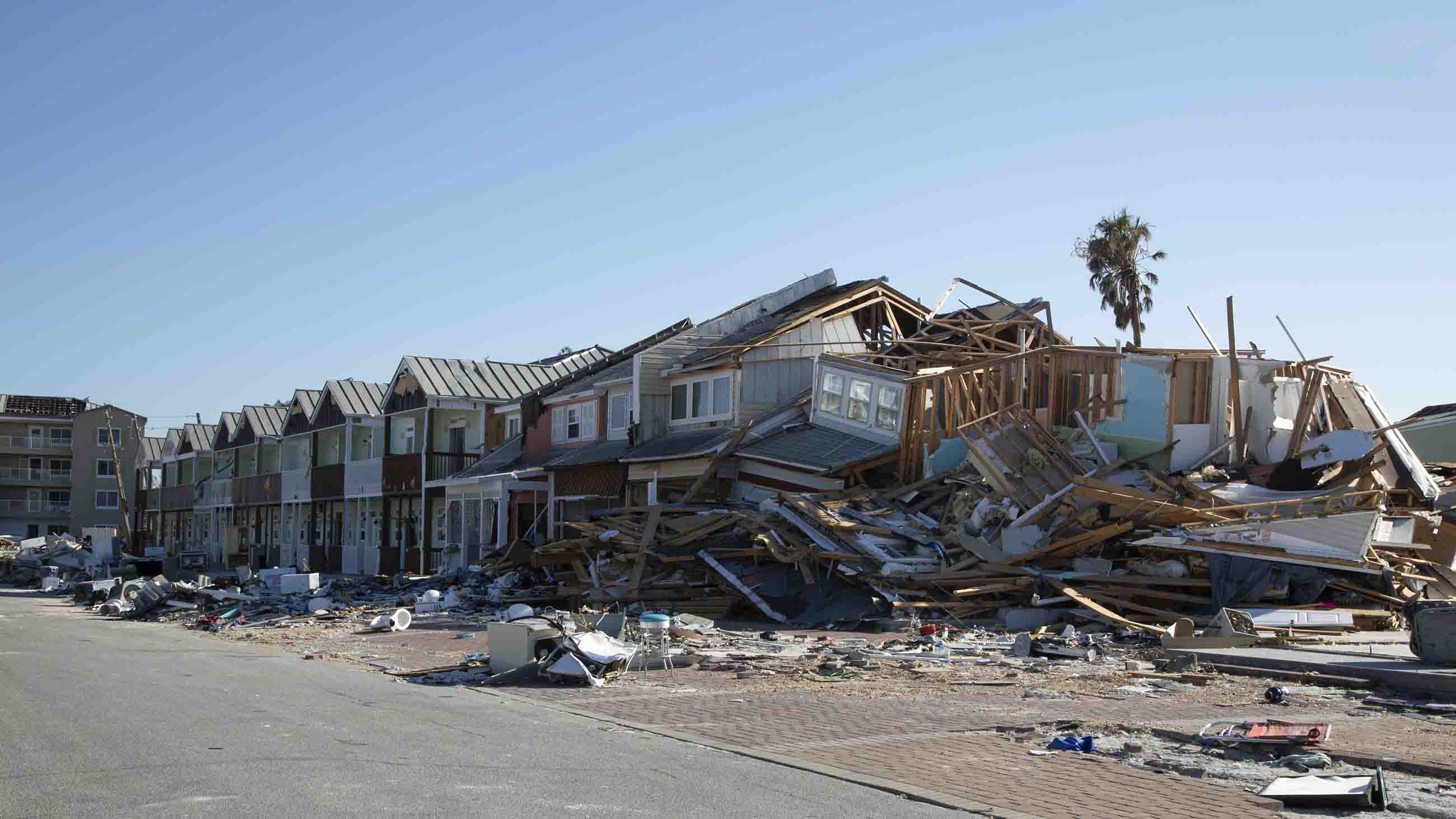When Hurricane Michael swept through the Florida panhandle earlier this month, it left behind a staggering trail of destruction: an estimated $10 to $12 billion in damages, dozens dead, and, at one point a week after the storm made landfall, more than 1,000 still missing. The storm plunged more than 1.3 million utility customers into darkness. Two weeks after landfall, more than half of residents in some counties still lacked electricity, more than 1,000 people remained in shelters, and many who’d returned home still had to boil their water before they could safely use it.

VIEWPOINTS
Partner content, op-eds, and Undark editorials.
Such tales of devastation have become all too familiar. In September, Hurricane Florence ravaged North Carolina and Virginia, leaving 51 dead and causing as much as $45 billion in property damage. A year earlier, Hurricane Irma killed 129 people and, by conservative estimates, cost $50 billion in total. A year before that, Hurricane Matthew swept through the Carolinas, causing $10 billion in damages and killing dozens of people in North Carolina, South Carolina, and neighboring states. And then there was 2017’s Hurricane Harvey, the costliest storm in the U.S. in more than a decade, which caused $125 billion in damage and left at least 88 people dead, mostly in Houston.
If you feel overwhelmed by these numbers, it’s because they’re, well, overwhelming. And as the climate continues to change, the numbers will only grow grimmer.
Although the precise impact of climate change on the intensity of natural disasters is disputed, the growing scientific consensus is that a connection exists. Much of the world has already accepted that consensus and responded in kind by incorporating climate science, among other disciplines, into policy decisions.
But the U.S. is different. We are the only country to have rejected the Paris Climate accord, signed by nearly 200 nations. And at the state and local level, many lawmakers have steadfastly resisted the integration of climate science into policymaking. That resistance has played out in dramatic fashion in coastal and inland communities alike. Ironically, the states hit hardest by climate-change-related extreme weather events are among the fiercest holdouts against adopting science-informed policy.
In Florida, for instance, employees at the Department of Environmental Protection and other state agencies cited an unwritten policy against the use of the words “climate change” and “global warming” in state-produced documents. There, an institutional culture skeptical of science has effectively tied the hands of regulators seeking to mitigate disasters with climate science-informed policies.
In North Carolina, the anti-science bias is even less subtle. In 2012, the state’s legislature passed House Bill 819, which strictly prevented state agencies from using scientific research on sea level rise and climate change to justify regulations. Drafted following a controversial, state-sponsored report on projected sea level rise and its threat to coastal locations, this law forbade the state’s Division of Coastal Management and Coastal Resource Commission from using such data and modeling “for regulatory purposes” until it expired in 2016. The law effectively barred those most empowered to address the problem of climate change from using the most accurate and relevant research during a critical period for the state.
And in Texas, which emits more greenhouse gas than any other state in the U.S., legislative leadership remains skeptical or silent on climate issues. Climate adaptation plans were proposed in the state’s House of Representatives during three consecutive legislative sessions — in 2009, 2011, and 2013 — but all three proposals were held up in committee procedure and never came to the floor for a vote.
So what would science-informed policy look like? It would take the form of states investing in the latest lidar technology to generate more accurate floodplain maps. It would mean steering developers away from hazard-prone areas to invest, instead, in areas that lie outside of 100-year flood zones, defined as those zones that will be inundated in a flood with a 1 percent chance of occurring in any given year. And it would bring planners, policymakers, and business leaders together to work toward understanding and mitigating greenhouse gas emissions — from the local to the international scale.
For cities and counties, smart science-informed policy might also mean engaging with neighboring municipalities to coordinate regional planning efforts. Natural events don’t follow human borders. Climate-related policy problems will need to be solved at the scales of watersheds, river valleys, and mountain ranges.
And if homes must be built in low-lying coastal areas, regulations should require them to be elevated several feet above the base flood elevation — the predicted water level associated with a 100-year flood. This last policy could have saved some of the 237 homes in Mexico Beach that were destroyed by the storm surge that raced up Florida’s panhandle, where current code requires only that homes be built one foot above base flood elevation.
Despite lukewarm support and a lack of guidance from state leadership, some state, local, and nongovernmental agencies have found innovative ways to advance such science-informed policies. North Carolina’s Coastal Resilience Center of Excellence, launched in 2015 with a grant from the Department of Homeland Security, is helping local governments incorporate the latest research in landscape architecture and planning in their disaster recovery plans. Texas A&M University’s Hazard Reduction & Recovery Center draws on the knowledge of researchers and practitioners to help communities across Texas manage the inevitable challenges posed by climate change. In 2010, four Florida counties struck out ahead of sluggish state leadership and banded together to form the Southeast Florida Regional Climate Change Compact, an alliance that aims to coordinate mitigation and adaptation activities. Those four counties — Broward, Miami-Dade, Monroe, and Palm Beach — are home to almost a third of the state’s population.
These innovative measures have never been more urgently needed. A recent report from the Intergovernmental Panel on Climate Change warns that we have just 12 years, until 2030, to limit global warming to 1.5 degrees Celsius. Failure to do so would jeopardize our chances at “a safe and sustainable world for everyone.” Drawing from more than 6,000 scientific references, the report’s 91 authors from 40 countries urged “far-reaching and unprecedented changes in all aspects of society.”
For policymakers here in the U.S., those changes should include a more explicit advocacy of climate science-informed policy. The losses associated with sea level rise, expanding floodplains, and climate-related natural disasters are no longer hypothetical — they’re here. And without science-informed leadership, the problems are likely to mount. The numbers speak for themselves.
Darien Alexander Williams is a doctoral student in MIT’s Department of Urban Studies & Planning, where he focuses on disaster recovery, community organizing, and marginalized populations. He has previously worked across eastern North Carolina on local planning in the aftermath of hurricane events.











Comments are automatically closed one year after article publication. Archived comments are below.
Holy B…Thnx for saying it for me.
Between Climate & Science Deniers and Christian Nationalists, death never looked so good to me.
Can’t bear it that so many want the world to look like and be as unsafe as a disaster movie. …nor that some people think they will get out of this world alive and go be with Jesus, even if they leave their still living in a living hell. Just that they think they will live on……
This is one sick country overall.
I can feel sorry for the children who are badly affected by these natural disasters, but not for the adults. If they choose to think that science is evil, let them reap that whirlwind.
So your house is in pieces because climate change isn’t real, so be it.
Don’t get any vaccinations, because they are based on science, which is evil. So get sick. Happy diphtheria to you.
Funny, though, how they hold on to their science-invented devices, like cars, microwaves, TVs, PCs, Androids, HVAC, refrigerators – and MUCH MORE. If you don’t abandon such devices entirely, you are sinning, because you have allowed SCIENCE into your lives. Truly evil you are. Especially because you would like to take those things away from everyone else. i guess it’s because you insist that the rest of us suffer the same things you ought to suffer. Cruelty, to you, is not a sin. Somehow.
You’ve brought your own suffering on yourselves – consciously. But you’ve also brought the suffering on your poor kids, and that’s disgusting.